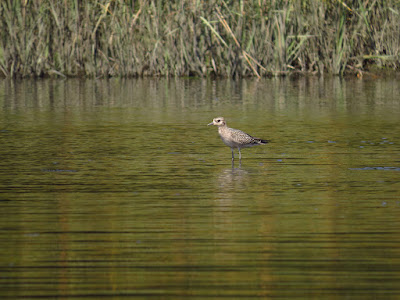It's a beautiful day with a light west wind. I set out with about three more hours of rising tiding.
I head down river from the landing below the highway bridge. The wind is a bit behind me, the current coming at me, but it all balances out and the paddle down is easy. I head into Nell's channel to take best advantage of the wind - a counterclockwise circuit of the marsh. Nell's is usually light on bird sightings, and it proves so once more. I spot just one immature Night Heron in the channel. |
| The typical view of a Night Heron (center of photo) |
I head out of the channel as soon as I can and start winding through the inner channels of the central marsh. Immediately, I begin flushing birds, and almost all of them flush before I see them. It is mostly immature Night Herons with a few adults, a few Great Blue Herons, some Mallards and maybe some Black Ducks. Then a few Snowy Egrets and some Great Egrets. By the time I am halfway around the circuit, I have a count of 30 immature Night Herons and 2 adult Yellow Crowned Night Herons. I stop counting at that point, but I easily double that number by the time I head out. I count 10 Great Blue Herons, almost all in the central area. As I head east, I sart spotting more Egrets. I spot two birds that look most like immature Golden Plovers, which would be on migration from the Arctic down to South America.
 |
| Immature Golden Plover on migration |
 |
| Snowy Egret |
The immature/mature Night Heron ratio is 15:1...that's what I was thinking about. All that means is that immature Night Herons like to stand where I can canoe, as, of course, there aren't 15 times as many immatures as there are adults. Herons aren't that prolific. It's possible that the immatures are less efficient at feeding and need to spend more time at the water's edge. It's also possible that the adults just know enough not to hang around in the open.
 |
| Immature Night Heron |
The return goes as easy as the paddle out with the last of the flood tide helping me along.


No comments:
Post a Comment